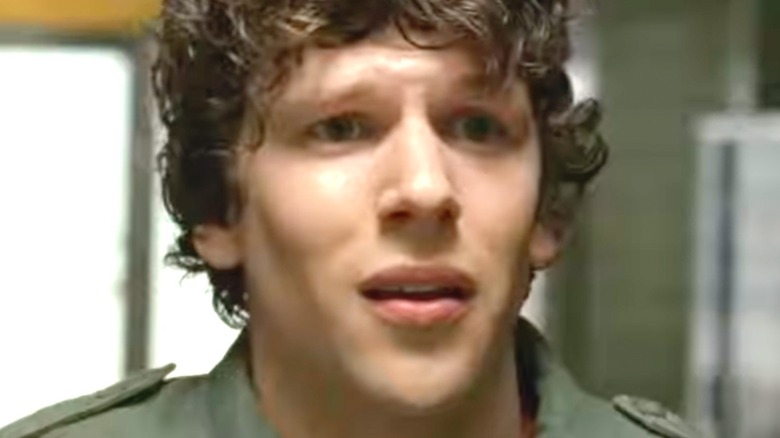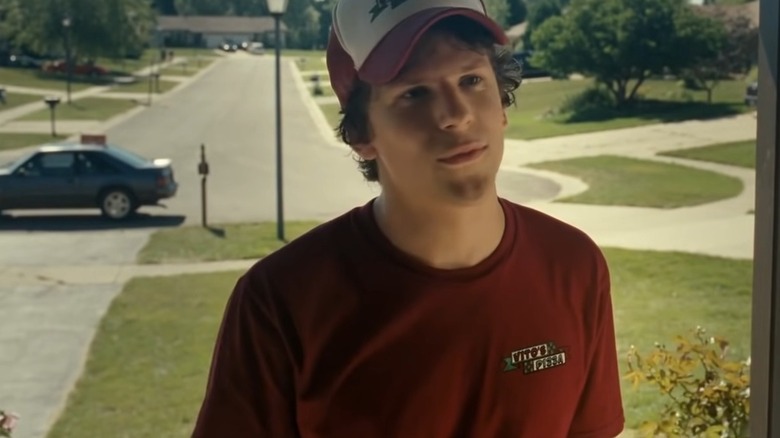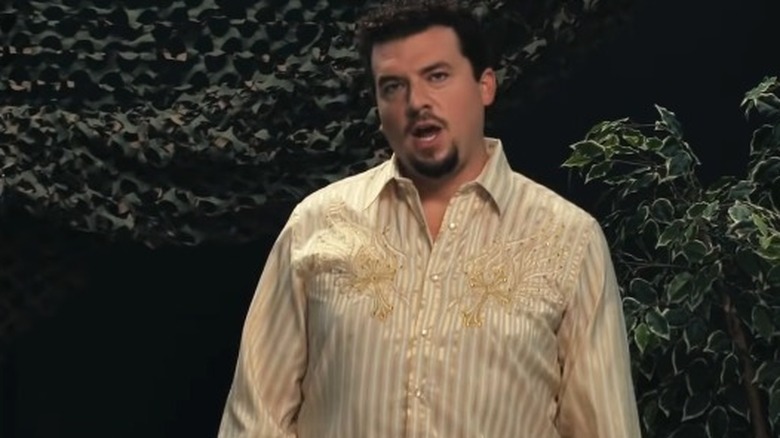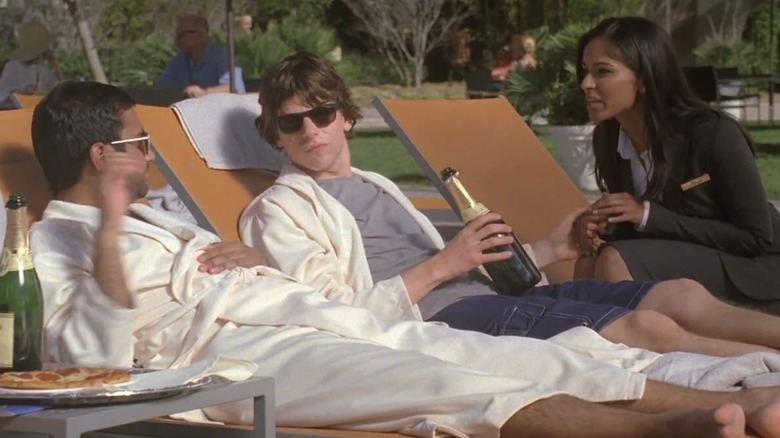The Ending Of 30 Minutes Or Less Explained
After helming the mega-successful "Zombieland" in 2009, director Ruben Fleischer teamed up again with Jesse Eisenberg for another comedic outing, 2011's "30 Minutes or Less." The film centers on a pizza delivery guy named Nick (Eisenberg) who finds himself tasked with robbing a bank after two dim-witted criminals strap a bomb to him. A ridiculous journey goes haywire as betrayals, assassins, and explosions factor into the story. "30 Minutes or Less" definitely had the ingredients to become box office hit, mainly thanks to a stellar cast that features Aziz Ansari, Danny McBride, Nick Swardson, Michael Peña, and the late Fred Ward.
Yet, the reaction to "30 Minutes or Less" was not on the same level as Fleischer's zombie hit. The film holds a discouraging audience score on Rotten Tomatoes, and the film's plot caught some controversy due to its similarity to an actual horrifying incident involving the death of a real-life pizza delivery guy named Brian Wells. Still, life past the box office has been a little kinder, as "30 Minutes or Less" defied odds and found a resurgence on Netflix. "30 Minutes or Less" can bring the laughs, but its ending, post-credits scene, and alternate ending makes what it all means a little confusing. Fortunately, we've got a deep dive to help bring it all into focus.
Everyone reaps what they sow
The ending of "30 Minutes or Less" wraps up somewhat neatly, as is typically expected with most comedy films. However, "30 Minutes or Less" accomplishes this by simply sticking to the old proverb of "You reap what you sow." Every bad deed gets punished, and the way everything plays out during the final act is almost poetic. While holding the stolen money in a scrapyard, Nick has a final confrontation with his tormentors Dwayne (McBride) and Travis (Swardson). After finally getting the code to deactivate the bomb, and some sniper rifle trickery involving Chet's (Ansari) laser pen, Nick almost escapes with Kate (Dilshad Vadsaria) and the stolen money. However, the hitman Chango (Peña) unexpectedly steps in, knocks Nick out, and attempts to take the money. That turns out to be the best thing that could happen to Nick — the bad guys proceed to take each other out. Travis uses his flamethrower on Chango, but Chango wounds Dwayne and shoots the gas tank to Travis' flamethrower, which explodes.
Nick, Kate, and Chet drive off with the money, but Dwayne is still alive and gives chase in his van. Fortunately, Nick has already reactivated the bomb and left it in Dwayne's van. Ironically, Dwayne's bomb plan comes back to literally blow up in his face. As a result, the bad guys get what they deserve. But before anyone thinks that cosmic justice is strictly for the antagonists, the last scene reinforces that our heroes are not exempt. As Nick, Kate, and Chet wonder how they'll spend the money, Chet opens the bag, and the blue dye slipped in during the bank robbery explodes in their face.
Nick and Dwayne aren't so different
Since they're the ones who devise the plot to strap a bomb to Nick, the explosive ends of Dwayne and Travis should feel like cinematic justice. But a memorable post-credits scene reveals that the criminal duo get a second chance. This may have been done to lighten the movie's dark and action-packed third act, because Fleischer wasn't completely happy about the sudden tone shift or the death of certain characters. In their redemptive post-credits scene, Dwayne and Travis unveil their new tanning salon business called "Major Tan." Despite being shot by Chango earlier in the film, Dwayne's father The Major (Ward) proudly works alongside his son. If the post-credits scene helps establish any other general theme about "30 Minutes or Less," it's that the good guys and bad guys aren't too different.
Before the chaotic events that intertwine the two, Nick is stuck working a minimum wage pizza delivery job while Dwayne simply loafs about at home, despite his father's ire. However, the two prove that they both contain far more potential. Both can pull off unlikely schemes, whether that's Dwayne's bomb-oriented plan to get his father's inheritance or Nick's sniper rifle ruse in the scrapyard. Both characters also have incredibly loyal friends in the form of Travis and Chet. Finally, Nick and Dwayne are desperate for better lives. Dwayne and Travis open a business after surviving their ordeal; Nick's first thought when retrieving the money isn't to turn it over to the authorities, but to spend it on himself.
The alternate ending fills in a few details
If the post-credits scene seemed out of left field, that might be because it fits better with the movie's alternate ending. The other conclusion starts basically where the original left off, but Dwayne emerges out of his destroyed van this time. After climbing out of the wreckage, he goes to see his wounded father. In their absurd way, the two make amends and Dwayne explains his tanning salon idea, which his father approves. It's almost a shame that this ending got cut, as it fills in some lingering details that definitely would have set up the post-credits scene a little better. However, as Fleischer said to IndieWire, the alternate ending didn't do too well with test audiences who said they found the father-son reconciliation scene boring. Apparently, the rest of that version of the ending didn't fare too well, either.
In that iteration, Nick, Kate, and Chet enjoy the spoils from the stolen bank money. While Nick and Chet lounge by the pool and Kate manages a special events program, it's stated that Chango is blamed for the robbery. Unlike in the official version, the good guys get away with stealing the money. There are no repercussions for them, and the whole vibe is much happier. But this alternate ending takes away from the movie's theme of certain consequences for certain actions. After all, it would be hypocritical if Nick got away with stealing the money.



